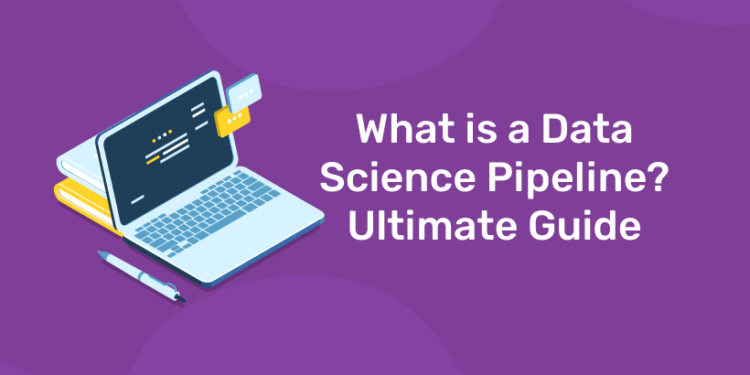Table of Contents
The increasing volume and complexity of enterprise data, as well as its central role in decision-making and strategic planning, are driving organizations to invest in the people, processes, and technologies required to gain valuable business insights from their data assets. This includes a wide range of tools commonly used in Data Science applications.
A Data Science Pipeline is a collection of processes that transform raw data into actionable business answers. Data Science Pipelines automate the flow of data from source to destination, providing you with insights to help you make business decisions.
Here’s a list of top Data Science Pipeline tools that may be able to help you with your analytics, listed with details on their features and capabilities – as well as some potential benefits.
What is Data Science?
Data Science is the study of massive amounts of data using sophisticated tools and methodologies to uncover patterns, derive relevant information, and make business decisions.
In a nutshell, Data Science is the science of data, which means that you use specific tools and technologies to study and analyze data, understand data, and generate useful insights from data. Data Science is an interdisciplinary field that includes Statistics, Machine Learning, and Algorithms.
A Data Scientist employs problem-solving skills and examines the data from various perspectives before arriving at a solution. A Data Scientist employs exploratory data analysis (EDA) and advanced machine learning techniques to forecast the occurrence of a given event in the future.
A Data Scientist examines business data in order to glean useful insights from the data. In order to solve business problems, a Data Scientist must also follow a set of procedures, such as:
- Inquiring about a situation in order to better understand it.
- Obtaining information from a variety of sources, including company data, public data, and others.
- Taking raw data and converting it into a format that can be analyzed.
- Creating models using Machine Learning algorithms or statistical methods based on data fed into the Analytic System.
- Conveying and preparing a report to share data and insights with appropriate stakeholders, such as Business Analysts.
What are Data Science Pipelines?
1: Which of the following algorithms is most suitable for classification tasks?
The Data Science Pipeline refers to the process and tools used to collect raw data from various sources, analyze it, and present the results in a Comprehensible Format. Companies use the process to answer specific business questions and generate actionable insights from real-world data. To find this information, all available Datasets, both External and Internal, are analyzed.
For example, your Sales Team would like to set realistic goals for the coming quarter. They can collect data from customer surveys or feedback, historical purchase orders, industry trends, and other sources using the data science pipeline. Robust data analysis tools are then used to thoroughly analyze the data and identify key trends and patterns. Teams can then set specific, data-driven goals to boost sales.
Grab the opportunity to learn Data Science with Entri! Click Here
Key Features of Data Science Pipelines
Here is a list of key features of the Data Science Pipeline:
- Continuous and Scalable Data Processing
- Cloud-based Elasticity and Agility.
- Data Processing Resources that are Self-Contained and Isolated.
- Access to a Large Amount of Data and the ability to self-serve.
- Disaster Recovery and High Availability
- Allow users to Delve into Insights at a Finer Level.
- Removes Data silos and Bottlenecks that cause Delays and Waste of Resources.
How does a Data Science Pipeline Work?
It is critical to have specific questions you want data to answer before moving raw data through the pipeline. This allows users to focus on the right data in order to uncover the right insights.
The Data Science Pipeline is divided into several stages, which are as follows:
- Obtaining Information
- Data Cleansing
- Data Exploration and Modeling
- Data Interpretation
- Data Revision
Grab the opportunity to learn Data Science with Entri! Click Here
1) Obtaining Information
This is the location where data from internal, external, and third-party sources is collected and converted into a usable format (XML, JSON, .csv, etc.).
2) Data Cleansing
This is the most time-consuming step. Anomalies in data, such as duplicate parameters, missing values, or irrelevant information, must be cleaned before creating a data visualization.
3) Data Exploration and Modeling
After thoroughly cleaning the data, it can be used to find patterns and values using data visualization tools and charts. This is where machine learning tools can help.
4) Data Interpretation
The goal of this step is to identify insights and then correlate them to your data findings. You can then use charts, dashboards, or reports to present your findings to business leaders or colleagues.
5) Data Revision
As business requirements change or more data becomes available, it’s critical to revisit your model and make any necessary changes. This is shown by the below image.
Best Tools for Data Science
The most effective Data science tools combine Machine Learning, Data Analysis, and statistics to produce rich, Detailed Data Visualization. Users (regardless of technical skill) can identify trends and patterns and make smarter decisions that accelerate business growth and revenue with the right tools in place.
As Data Science teams build their portfolios of enabling technologies, they have a wide range of tools and platforms to choose from. Here are the top 5 data science tools that may be able to help you with your analytics, with details on their features and capabilities.
- Statistical Analysis System (SAS)
- Apache Hadoop
- BigML
- D3.js
- MATLAB
1) Statistical Analysis System (SAS)
The SAS Institute created SAS, a statistical and complex analytics tool. It is one of the oldest data analysis tools, designed primarily for statistical operations. SAS is popular among professionals and organizations that rely heavily on advanced analytics and complex statistical operations. This dependable commercial software offers a variety of statistical libraries and tools for modeling and organizing the given data.
These Data Science tools have the following key features and applications:
- It is simple to learn because it comes with plenty of tutorials and dedicated technical support.
- A straightforward graphical user interface that generates powerful reports
- carries out textual content analysis, including typo detection
- Offers a well-managed suite of tools for data mining, clinical trial analysis, statistical analysis, business intelligence applications, econometrics, and time-series analysis.
2) Apache Hadoop
Apache Hadoop is an open-source framework that aids in the distributed processing and computation of large datasets across a cluster of thousands of computers, allowing it to store and manage massive amounts of data. It is an excellent tool for dealing with large amounts of data and high-level computations.
The following are some of Hadoop’s key features and applications:
- Scales large amounts of data efficiently across thousands of Hadoop clusters.
- Hadoop Distributed File System (HDFS) is used for data storage and parallel computing.
- Even in unfavorable conditions, it provides fault tolerance and high availability.
- Integrates with other data processing modules such as Hadoop YARN, Hadoop MapReduce, and many others.
3) BigML
BigML is a scalable machine learning platform that enables users to leverage and automate techniques like classification, regression, cluster analysis, time series, anomaly detection, forecasting, and other well-known machine learning methods in a single framework. BigML provides a fully interchangeable, cloud-based GUI environment for processing machine learning algorithms, with the goal of reducing platform dependencies. It also provides customized software for using cloud computing to meet the needs and requirements of organizations.
BigML’s main features and applications are as follows:
- Aids in the processing of machine learning algorithms
- It is simple to create and visualize machine learning models.
- For supervised learning, methods such as regression (linear regression, trees, etc.), classification, and time-series forecasting are used.
- Unsupervised learning is accomplished through the use of cluster analysis, association discovery, anomaly detection, and other techniques.
4) D3.js
D3.js is a JavaScript library that allows you to create automated web browser visualizations. It offers a number of APIs through which you can access a variety of functions to create interactive data visualizations and perform meaningful data analysis in your browser. Another noteworthy feature of D3.js is that it generates dynamic documents by allowing client-side updates and reflects changes in visualizations in relation to changes in data on the browser.
The following are some of D3.js’s key features:
- Emphasizes the use of web standards in order to fully utilize the capabilities of modern browsers.
- Combines powerful visualization modules and a data-driven process to manipulate the document object model (DOM).
- Aids in the application of data-driven transformations to documents following the binding of data to DOM.
Grab the opportunity to learn Data Science with Entri! Click Here
5) MATLAB
Matrix Laboratory (MATLAB) is a multi-paradigm programming language that aids in the creation of a numerical computing environment for the processing of mathematical expressions. The most important feature of this language is that it assists users with algorithmic implementation, matrix functions, and statistical data modeling. It is widely used in a variety of scientific disciplines.
MATLAB is used in the following ways:
- Aids in the development of algorithms and models
- For iterative analysis and design processes, it combines the desktop environment with a programming language.
- Provides an interface comprised of interactive apps for testing how various algorithms perform when applied to the data at hand.
- Aids in the automation and replication of work by automatically generating a MATLAB program.
- Scales up the analysis process to run on clusters, the cloud, or GPUs.
Are you aspiring for a booming career in IT? If YES, then dive in |
||
Full Stack Developer Course |
Python Programming Course |
Data Science and Machine Learning Course |
How do Various Industries make use of the Data Science Pipeline?
Regardless of industry, the Data Science Pipeline benefits teams. Here are some examples of how different teams have used the process:
1) Data Science Pipeline for Risk Analysis
Risk Analysis is a process used by financial institutions to make sense of large amounts of unstructured data in order to determine where potential risks from competitors, the market, or customers exist and how they can be avoided.
Furthermore, organizations have used Domo’s DSML tools and model insights to perform proactive risk management and risk mitigation.
2) Data Science Pipeline in Medical Field
Medical professionals rely on data science to help them conduct research. One study uses machine learning algorithms to help with research into how to improve image quality in MRIs and x-rays.
Companies outside of the medical field have had success using Domo’s Natural Language Processing and DSML to predict how specific actions will impact the customer experience. This allows them to anticipate risks and maintain a positive experience.
3) Data Science Pipeline for Forecasting
The Transportation industry employs data science pipelines to forecast the impact of construction or other road projects on traffic. This also aids professionals in developing effective responses.
Other business teams have had success forecasting future product demand using Domo’s DSML solutions. The platform includes SKU-level multivariate time series modeling, allowing them to properly plan across the supply chain and beyond.
Benefits of Data Science Pipeline
Listed below are some benefits of the Data Science Pipeline:
- Increases Responsiveness to Changing Business needs and Customer Preferences.
- Access to Company and Customer Insights is made easier.
- It Expedites the Decision-Making process.
- Allow users to delve into Insights at a finer level.
- Removes Data Silos and Bottlenecks that cause delays and waste Resources.
- Simplifies and Accelerates Data Analysis.
be a data scientist with online course in your native language !
Types of Data Pipeline Tools
Depending on the purpose, there are different types of Data Pipeline tools available. The popular types are as follows:
- Batch vs Real-time Data Pipeline Tools
- Open source vs Proprietary Data Pipeline Tools
- On-premise vs Cloud-native Data Pipeline Tools
1) Batch vs Real-time Data Pipeline Tools
Batch Data Pipeline tools allow you to move data, usually a very large volume, at a regular interval or batches. This comes at the expense of real-time operation. More often than not, these type of tools is used for on-premise data sources or in cases where real-time processing can constrain regular business operation due to limited resources. Some of the famous Batch Data Pipeline tools are as follows:
- Informatica PowerCenter
- IBM InfoSphere DataStage
- Talend
- Pentaho
The real-time ETL tools are optimized to process data in real-time. Hence, these are perfect if you are looking to have analysis ready at your fingertips day in-day out. These tools also work well if you are looking to extract data from a streaming source, e.g. the data from user interactions that happen on your website/mobile application. Some of the famous real-time data pipeline tools are as follows:
- Hevo Data
- Confluent
- Estuary Flow
- StreamSets
2) Open Source vs Proprietary Data Pipeline Tools
Open Source means the underlying technology of the tool is publicly available and therefore needs customization for every use case. This type of Data Pipeline tool is free or charges a very nominal price. This also means you would need to have the required expertise to develop and extend its functionality as per need. Some of the known Open Source Data Pipeline tools are:
- Talend
- Apache Kafka
- Apache Airflow
The Proprietary Data Pipeline tools are tailored as per specific business use, therefore require no customization and expertise for maintenance on the user’s part. They mostly work out of the box. Here are some of the best Proprietary Data Pipeline tools that you should explore:
- Hevo Data
- Blendo
- Fly Data
3) On-premises vs Cloud-native Data Pipeline Tools
Previously, businesses had all their data stored in On-premise systems. Hence, a Data Lake or Data Warehouse also had to be set up On-premise. These Data Pipeline tools clearly offer better security as they are deployed on the customer’s local infrastructure. Some of the platforms that support On-premise Data Pipelines are:
- Informatica Powercenter
- Talend
- Oracle Data Integrator
Cloud-native Data Pipeline tools allow the transfer and processing of Cloud-based data to Data Warehouses hosted in the cloud. Here the vendor hosts the Data Pipeline allowing the customer to save resources on infrastructure. Cloud-based service providers put a heavy focus on security as well. The platforms that support Cloud Data Pipelines are as follows:
- Hevo Data
- Blendo
- Confluent
The choice of a Data Pipeline that would suit you is based on many factors unique to your business. Let us look at some criteria that might help you further narrow down your choice of Data Pipeline Tool.
Entri gives you the best Coding experience
Conclusion
In today’s data-driven world, data is critical for survival of any organization in this competitive era. Data Scientists use data to provide impactful insights to key decision-makers in organizations. This is nearly impossible to imagine without the use of the powerful Data Science tools listed above.
The Data Science Pipeline is the key to releasing insights that have been locked away in increasingly large and complex datasets. With the volume of data available to businesses expected to increase, teams must rely on a process that breaks down datasets and presents actionable insights in real-time.
The Agility and Speed of the Data Science Pipeline will only improve as new technology emerges. The process will become smarter, more agile, and more accommodating, allowing teams to delve into data in greater depth than ever before.
To become more efficient in handling your Databases, it is preferable to integrate them with a solution that can carry out Data Integration and Management procedures for you without much ado and that is where Hevo Data, a Cloud-based ETL Tool, comes in. Hevo Data supports 100+ Data Sources and helps you transfer your data from these sources to Data Warehouses in a matter of minutes, all without writing any code!
Related Articles
| Our Other Courses | ||
| MEP Course | Quantity Surveying Course | Montessori Teachers Training Course |
| Performance Marketing Course | Practical Accounting Course | Yoga Teachers Training Course |











